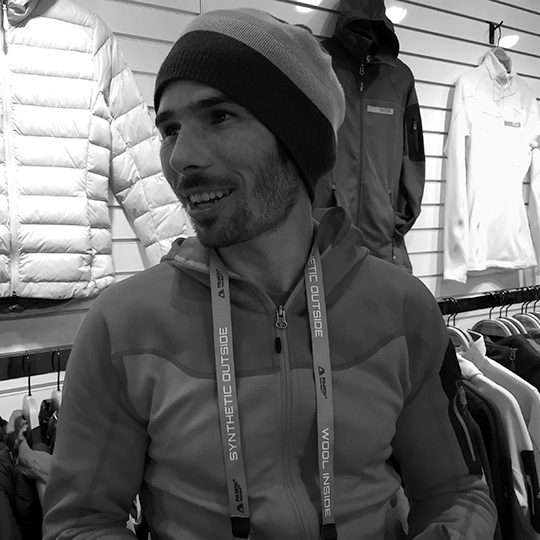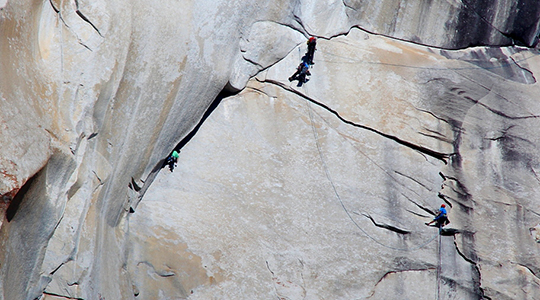
[Photo] Chris Van Leuven
It’s 3:25 p.m. on Thursday, January 22, Day 3 of the Outdoor Retailer show in Salt Lake City, Utah, and I’m about to interview Kevin Jorgeson. It’s been eight days since he and Tommy Caldwell finished their nineteen-day bottom-to-top push up El Cap’s 3,000-foot Dawn Wall, in Yosemite Valley, California, completing the most difficult free climb on El Cap–and likely the most difficult free big wall in the world–at 5.14d, 32 pitches.
Thirty-year-old Jorgeson is sitting on the table across a narrow walkway from me. He’s wrapping up a phone conversation through his headphone mic. Our interview starts in four minutes. We’re at one of the booths, a spacious white square on the far end of the climbing-hardware sector of the show. John Long, who with Billy Westbay and Jim Bridwell completed the first one-day ascent of El Cap’s Nose route in 1975, walks by carrying a yellow jacket, the same color as the one sitting behind Jorgeson’s chair; it’s also the same color jacket Jorgeson wore on the Dawn Wall and that was seen in newspapers around the world.
Earlier today, I saw Jorgeson signing posters of himself and Caldwell on the Dawn Wall. Dozens of people eagerly lined up.

[Photo] Chris Van Leuven
A large scabs covers the back of one of Jorgeson’s hands and little pepper-shaped scab holes dot the back of his fingers. He’s wearing a blue, orange and gray beanie, stretchy tight-fitting orange hoody, blue jeans and teal and black sneakers.
He rests his thumb and pointer finger against the side of his head, and leans into his call.
I have an interview with you, I say.
“I know,” he replies. “In a few minutes.”
Two minutes past 3:30 he comes over. “I’m two minutes late,” he says with a smile. “I’m sorry. It’s a pet peeve I have–I try to be on time.” He takes a bite of his mini chocolate bar.
He shows me his hands. The tips of his fingers are peeling and look as if they’re covered in blobs of rubber cement–his calluses, earned from crimping sharp, micro holds on the smooth wall for nearly three weeks straight, are exfoliating in big layers.
“I got so skinny on the wall, I’ll eat anything,” he says to two people at the next table over. Then he opens another mini chocolate bar.
I set up this interview because I was eager to learn about Jorgeson’s last day on the wall. Having climbed El Cap dozens of times myself, I know firsthand that the monolith is never easy to finish. And, as the world watched him and Caldwell, I knew that the pressure to perform must have been enormous.
Alpinist: Tell me about the terrain you covered on Day 19. How familiar were you with it?
Kevin Jorgeson: We’d climbed the pitches once in 2009 or 2010. We hadn’t done them in a long time. The hardest pitch after Wino Tower is 13a. It was a single slab move. It’s mostly 5.12. [And] there’s route finding. It’s a bit more burly, dirty and adventurous.
Alpinist: Did you fall?

[Photo] Tom Evans
KJ: I fell off above the Ship’s Bow. Pitch 29. The one time we tried before, it felt virtually impossible. [On Day 19 of our free push,] I tried it Tommy’s way and I thought I was screwed. That technique just didn’t work for me, and I fell.
It’s a flare. Not even close to parallel. Tommy went right side in. [After falling,] I went left side in not knowing if I would be able to do it. I was pasting my feet on nachos that look like they’re glued to the wall. I couldn’t have led it facing that way. After I fell, I explored the left-side-in technique, discovered it would work and finished the pitch so I knew what was coming. Then I went back to the Ship’s Bow [where we’d bivied] and did it.
Tommy’s way more optimistic and experienced than me. To me, it’s not over till it’s over. I just climb better that way. It’s not that I didn’t think we’d do it after Wino Tower; I just have to keep that mindset to myself.
Alpinist: How do Ambrosia and the Dawn Wall compare?
KJ: Ambrosia is a 45-foot 5.14 solo, basically. It’s a V11 to a 5.12. [On the Grandpa Peabody Boulder, near Bishop, California–Ed.]
I was done highballing after that. That was the end of an era to me. I was riding the line of free soloing at that point. I had found what I had wanted to find and was satiated.
Alpinist: Are there comparisons between that problem and the Dawn Wall?
KJ: They’re both first ascents. My inspiration comes [from doing] something new. The common thread is the experience and of taking something that doesn’t exist and turning it into something that exists. That was my motivation to join the Dawn Wall project.
I want to climb El Cap again. Eventually. I want to feel that flow of doing it in a day or doing other free routes. It’s beautiful up there. But for now, I just want to do Type 1 climbing for fun. I don’t know for how long. It will be hard and stressful [when I take on my next challenging project], but for now I just want to do some fun climbing.
Alpinist: Were you really going to bring crashpads up to cover your portaledges from falling ice if it hadn’t stopped?
KJ: Yes.
Alpinist: Do you feel like you got older up there?
KJ: I aged a lot. Tommy is up there now to rig for a Big Up Productions/Sender Films project of some kind. Just helping them get ropes in place.
Alpinist: How did you deal with the pressure of P15 [a 5.14d, which took him several days spread over a week to complete, while the world watched and waited]?
KJ: I was resolved to climb the route. I didn’t want to be the guy who almost did the Dawn Wall. I texted that to [my girlfriend] Jacqui [Becker]. I just had another evening session on it, was feeling pretty down and I got resolved to do it. I like to finish what I start, so I was going to finish it.
You feel that pressure to have that spotlight. You want to do right by your community and your tribe and your partners who support you.
Alpinist: What did you and Tommy teach each other?
KJ: I think Tommy taught me to be more optimistic. I can’t speak for Tommy.
Alpinist: How did the last pitch feel?
KJ: It felt like the weight of the dream, of the stress, of the hope–all the things wrapped into the project–just fell away at the top. And it’s just quiet, and it’s weightless and amazing. It’s baggage in a way. Your desire, your hope–it can weigh you down a little bit. When it’s done, you’re free and there’s nowhere else to go; you’re free and weightless.
Jorgeson lets out big tooth-showing grin to conclude our interview.
For more about his and Caldwell’s ascent, please read our in-depth article “Free at Last,” posted just after the completed ascent.